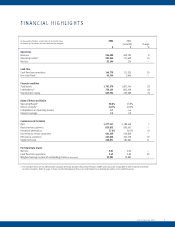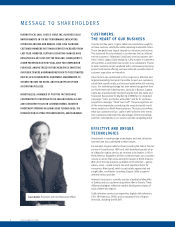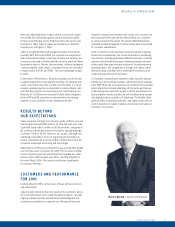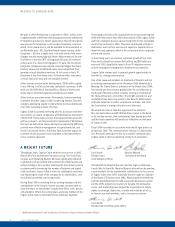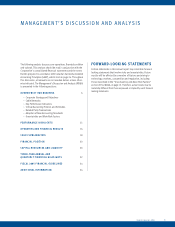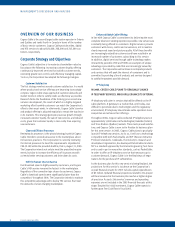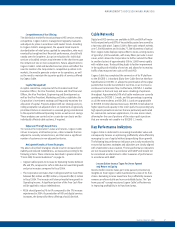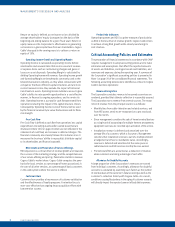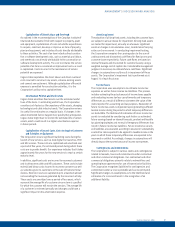Cogeco 2004 Annual Report Download - page 11
Download and view the complete annual report
Please find page 11 of the 2004 Cogeco annual report below. You can navigate through the pages in the report by either clicking on the pages listed below, or by using the keyword search tool below to find specific information within the annual report.
MANAGEMENT’S DISCUSSION AND ANALYSIS
Cogeco Cable Inc. 2004 9
Capitalization of Direct Labour and Overhead
As outlined in the recommendations of the Canadian Institute of
Chartered Accountants (CICA) with respect to property, plant
and equipment, capitalization of costs include the expenditures
to acquire, construct, develop or improve an item of property,
plant and equipment, and includes all costs directly attributable
to those activities. The cost of an item includes direct construc-
tion or software development costs, such as materials and labour,
and overhead costs directly attributable to the construction or
software development activity. The cost to enhance the service
potential of an item is considered an improvement and as a result
is capitalized. Costs incurred in the maintenance of service
potential are expensed.
Cogeco Cable capitalizes the direct labour and direct overhead
costs incurred to construct new assets, enhance existing assets
and connect new customers. Although capitalization of financial
expense is permitted for construction activities, it is the
Corporation’s policy not to capitalize them.
Amortization Policies and Useful Lives
Cogeco Cable amortizes fixed assets over the estimated useful
lives of the items. In estimating useful lives, the Corporation
considers such factors as life expectancy of the assets, changing
technologies and cable industry trends. The Corporation reviews
its useful lives estimates on a regular basis. If changes in the
above-mentioned factors happen more quickly than anticipated,
Cogeco Cable might have to shorten the estimated life of certain
assets, which could result in a higher amortization expense
in future periods.
Capitalization of Launch Costs, Costs to Acquire Customers
and Subsidies on Equipment
The Corporation incurs significant marketing costs during the
launch of new services, such as new digital tier launches, VOD
and HSI services. These costs are capitalized and amortized over
aperiod of five years, the estimated period during which these
costs are to provide benefit. Our experience indicates that it takes
approximately five years for the new services to reach a certain
maturity level.
In addition, significant costs are incurred to reconnect customers
and to attract new cable and HSI customers. These costs include
material and labour costs incurred to reconnect customers as well
as subsidies given to customers on the sale of home terminal
devices. Reconnect costs are capitalized up to a maximum amount
not exceeding the revenues generated by the reconnect activity.
These costs are amortized over a period of four years, which
represent the average life of a customer since no term is specified
for which the customer will receive the services. The average life
of a customer is reviewed annually and changes could have a
significant impact on the amortization expense.
Asset Impairment
The valuation of all long-lived assets, including the customer base,
are subject to annual review for impairment. All long-lived assets
are tested for impairment, annually or whenever significant
events or changes in circumstances occur, to determine if carrying
value can be recovered. In conducting impairment testing,
the Corporation compares the carrying value to the sum of
undiscounted and discounted cash flows for fixed assets and
customer base respectively. Future cash flows are based on
internal forecasts and discounted for customer base by using a
weighted average cost of capital rate. Considerable management
judgment is necessary to estimate future cash flows. Significant
changes in assumptions could result in impairment of these
assets. The Corporation’s impairment test is performed as at
August 31 of each fiscal year.
Income Taxes
The Corporation uses assumptions to estimate income tax
expenses as well as future income tax liabilities. This process
includes estimating the actual amount of income taxes payable
and evaluating income tax loss carry-forwards and temporary
differences as a result of differences between the value of the
items reported for accounting and tax purposes. Realization of
future income tax assets is dependant upon generating sufficient
taxable income during the period in which temporary differences
are deductible. The likelihood of realization of future income tax
assets is evaluated by considering such factors as estimated
future earnings based on internal forecasts, prudent and feasible
tax planning strategies and reversal of temporary differences that
result in future income tax liabilities. Future income tax assets
and liabilities are calculated according to enacted or substantially
enacted tax rates expected to be applied to taxable income in the
years in which those temporary differences are expected to be
recovered or settled. Accordingly, changes in assumptions will
directly impact the reported amount of income tax expenses.
Contingencies and Commitments
The Corporation is subject to various claims and contingencies
related to lawsuits, taxes and commitments under contractual
and other commercial obligations. Our contractual and other
commercial obligations primarily relate to network fees and
operating lease agreements for use of transmission facilities.
The Corporation recognizes liabilities for contingencies and
commitments when a loss is probable and can be estimated.
Significant changes in assumptions as to the likelihood and
estimates of a loss could result in the recognition of an
additional liability.



